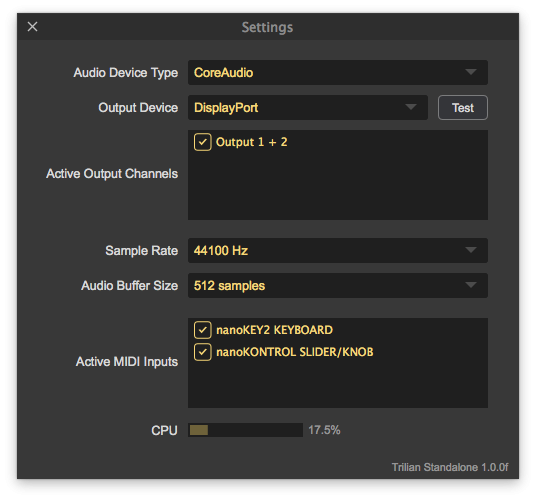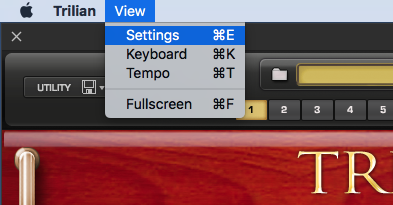
Click on the View Menu to select “Settings” or simply hit “Command–E / Control-E” to bring up the Settings window.


When you open the Settings window, it reflects your current settings and allows you to view and set your audio / MIDI preferences for the Trilian Standalone.
- Audio Device Type – Sets which audio driver is used by Trilian. Mac systems typically use CoreAudio and Windows systems typically use some variant of the ASIO drivers (we recommend ASIO4ALL.)
- Output Device – Determines which audio device is used by Trilian. This can be an internal speaker, an audio card, or a dedicated audio interface.
- Active Output Channels – Determines which audio output on your interface is used by Trilian.
- Sample Rate – Trilian’s sample rate can be set to either 44.1k, 48k, 88.2k, or 96k.
- Audio Buffer Size – Determines the amount of latency in the Trilian Standalone. Lower buffer settings have less latency, but tax your system resources to a greater degree (you might experience audio glitches or pops at lower buffer settings.) We recommend experimenting to find a good balance between latency and performance. Trilian’s Audio Buffer Size can be set from 32 to 1024 samples.
- Active MIDI Inputs – Lists the active MIDI devices connected to your computer. You can select which MIDI input you want to trigger Trilian.
- CPU – Measures the percentage of the computer’s processing power being used by Trilian.
Hitting “Command–E / Control-E” again or clicking on the “X” in the upper left corner closes the Settings window.
NOTE: “Command–W / Control-W” also closes the Settings window when it is in-focus.
NOTE: Settings made to the Trilian Standalone do not affect how Trilian works as a plug-in within any host.
Need more help with this?
Spectrasonics Customer Support



